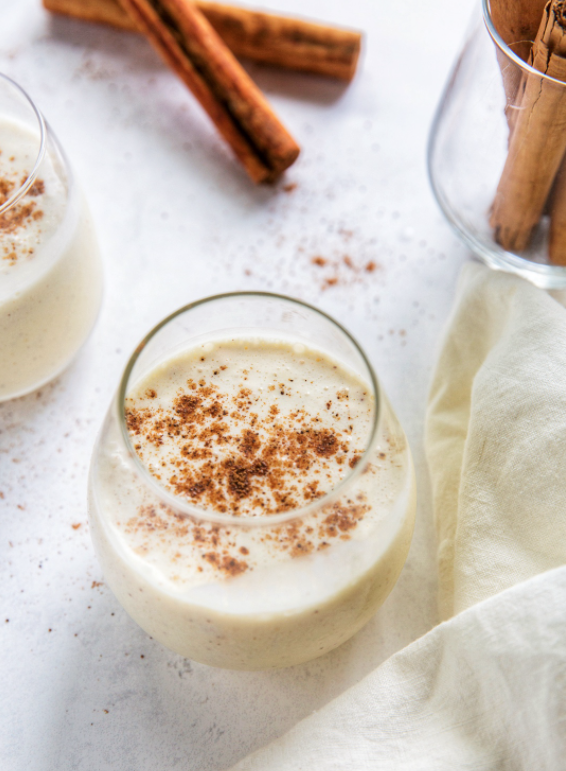By: Heidi Wagenbach
I love eggnog. Love it— but I can’t have too much or else my stomach feels awful the remainder of the night. It’s rich like a milkshake and the only one I ever drink is made by my aunt, whose recipe I would argue is the best in the world. It’s been a holiday treat in our household ever since I was young and I continue to accept a glass of the plain version, a lifestyle choice of avoiding alcohol. But, I’m sure you’ve never known the background of this rather controversial drink that some people love and others won’t touch with a 39 and a half inch pole… (Grinch reference, see what I did there?) Well, never fear, I’m here to educate you on the somewhat mysterious but nevertheless entertainingly jarring history of eggnog.
The Beginnings
The exact origin of eggnog is debated. Historians aren’t quite sure when eggnog first came to be but most agree that it was in the 13th century, in early medieval Britain when an early version first gained popularity (before refrigeration, mind you). It was called “posset,” a milky, hot, ale-like beverage that monks drank with figs. Milk, eggs, and alcohol, especially sherry, were foods of the wealthy, and most often indulged during toasts, representing prosperity and good health. Come the 1700s, eggnog began being associated with the holidays because American colonies were full of farms and cheap rum. Colonial America enjoyed thick drinks and called eggnog “egg-and-grog”. Breaking down the word itself: “nog” comes from “noggin,” or a wooden cup used during 1588, and “grog” was a strong beer. By the 18th century, the name “eggnog” was stuck.
Adding Liquor To The Mix
The rum version became the most popular for people of all classes because that alcohol was one that everyone could afford and was not nearly taxed as much as other liquors. The recipes vary throughout America and the rest of the world, for example: in the Southern states, they prefer whiskey, while Mexico has “rompope,” and Puerto Rico has “coquito,” adding coconut milk to eggnog as opposed to cream.
George Washington’s Recipe (Yep, You Read That Right)
The first President of the United States himself had a recipe, despite not recording how many eggs he added (cooks estimate it was about 12).
1 qt. – cream
1 qt. – whiskey
12 Tbsp – sugar
1 pint – brandy
½ pint – rye whiskey
½ pint – Jamaica rum
¼ pint – sherry
- Mix liquor first, separate yolks and whites of eggs, add sugar to yolks, mix well.
- Add milk and cream, slowly beating.
- Beat whites of eggs until stiff and fold slowly into mixture. Let set and cool for several days. Taste frequently.
Speaking of Presidents, President Dwight Eisenhower liked eggnog and had his own recipe that included coffee cream and whipping cream.
The Eggnog Riot of 1826 (Don’t Laugh, It Happened)
This situation occurred in West Point, New York in the United States Military Academy on December 24th and 25th, 1826. Superintendent Colonel Sylvanus Thayer had banned alcohol on the premises, and for good reason, simple math demonstrated by the equation below.
Parties + alcohol + students = chaos.
90 cadets drank eggnog after smuggling some liquor onto campus and went out of control. Two officers were assaulted, windows were broken, banisters were torn, dishes were smashed and ultimately, 19 students were charged in court and 11 of the cadets were expelled. Who knew eggnog would cause such ironic misery?
And this wasn’t the first time either; there are 19th century articles that describe fights and stabbings after people drank too much. Eggnog took a hit during Prohibition (1920-1933) however; people wanted it more now that it was forbidden.
Current Influence
Fans argue that people who don’t enjoy eggnog have never experienced the “real thing.” Looking at supermarket variations can not compare to the homemade yumminess, that include actual ingredients as opposed to hardly any egg (FDA regulations) and an overwhelming amount of sugar. The 1960s was when eggnog really became mainstream. Sales have shot up in the last 50 years, to where we drink 130 million pounds of it during the holidays. You can also buy different types of eggnog now, with flavors such as: pumpkin, vanilla, caramel, cinnamon, as well as finding that ice cream or even protein powder wants to share the iconic, familiar flavor of eggnog. And Christmas isn’t the only time eggnog is drunk now: New Year’s Eve, George Washington’s birthday (February 22nd), and the Fourth of July have become holidays that mostly partake because of the infused liquor and guarantee to get a little buzzed.
In Conclusion…
The history of eggnog is wild… and be careful not to overdo how many cups you have of this delicious, creamy mixture… seeing that each will stack up 400 calories each. I don’t doubt that eggnog will remain an iconic drink that, as said previously, will make people say “yum” or “gross” whenever it’s offered at holiday celebrations. For me, I’ll always partake but understand how the thought of slurping down raw eggs doesn’t sound too appealing, unless you’re a bodybuilder whose morning breakfasts don’t look too different.
Sources:
History and Origins of Eggnog: A Favorite Christmas Cocktail
A Brief History of Eggnog: Its Past, Including The Infamous Eggnog Riot, Is Stranger Than You Think

